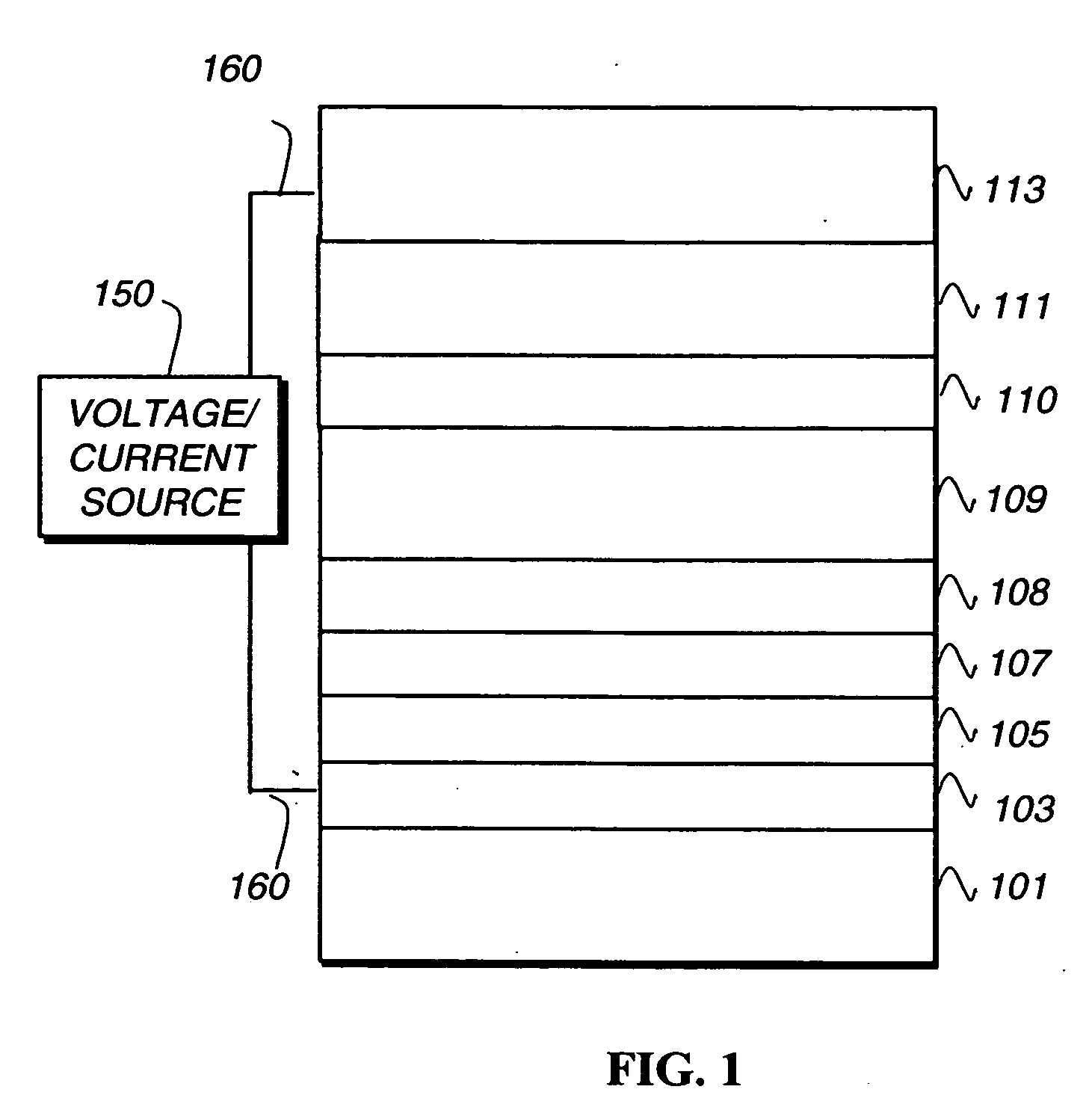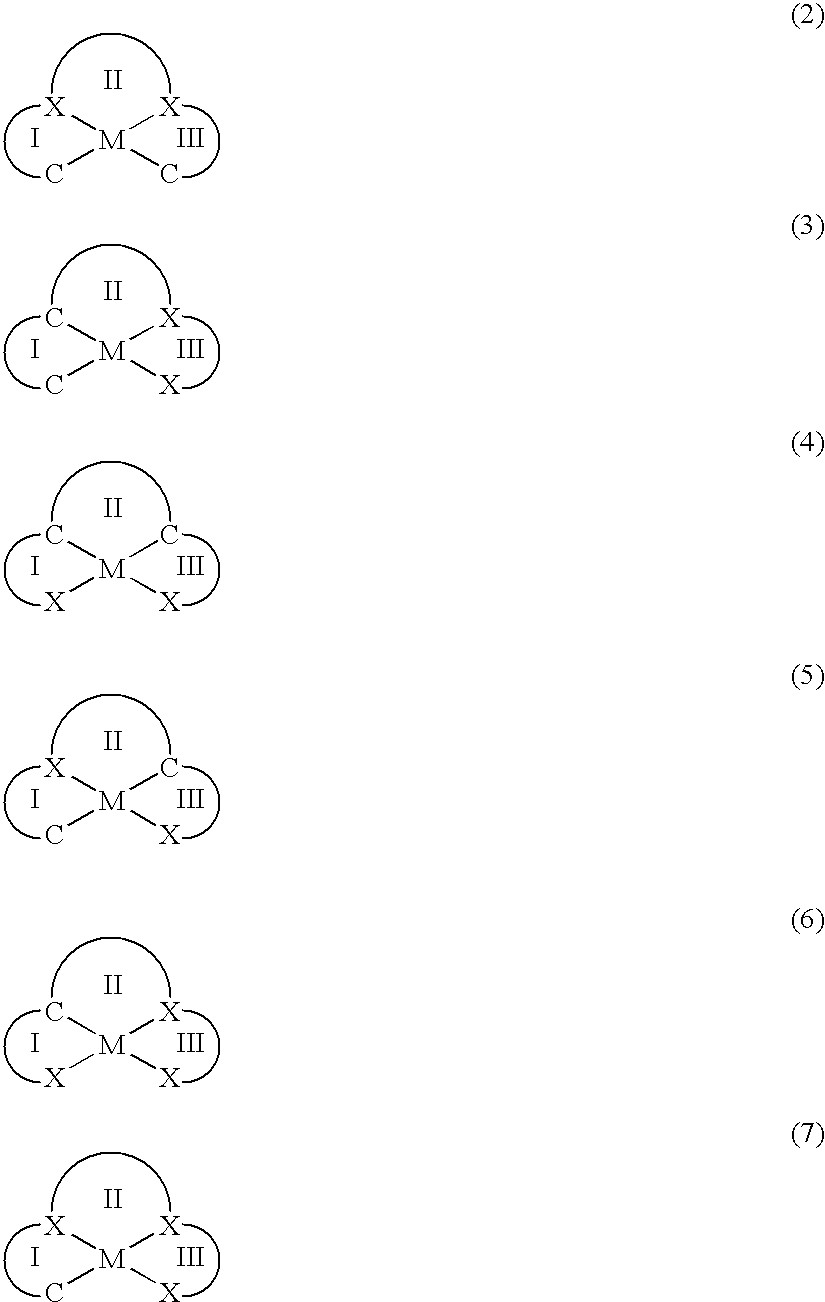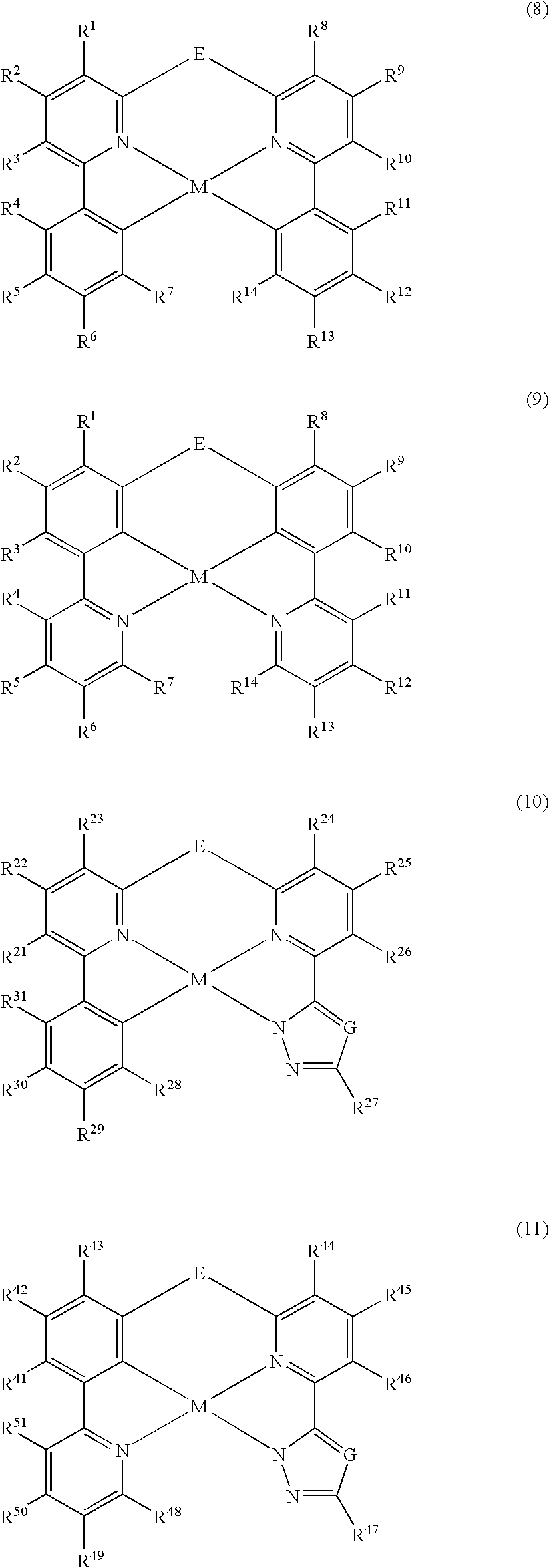Organometallic materials and electroluminescent devices
a technology of electroluminescent devices and organic materials, applied in the direction of luminescnet screens, discharge tubes, natural mineral layered products, etc., can solve the problems of large efficiency loss, large performance limitation, and insufficient investigation of pt-based organometallic complexes, etc., to improve efficiency, stability, and/or spectral characteristics.
- Summary
- Abstract
- Description
- Claims
- Application Information
AI Technical Summary
Benefits of technology
Problems solved by technology
Method used
Image
Examples
synthetic example 1
[0204] Synthesis of Organometallic Compound Inv-(1)
[0205] Synthesis of N,N-di-(6-bromopyrid-2-yl)aniline: A mixture of 2,6-dibromopyridine (11.85 g, 50 mmol), sodium tert-butoxide (4.8 g, 50 mmol), Pd2(dba)3 (366 mg, 0.4 mmol), DPPF (1,1′-bis(diphenylphosphino)ferrocene) (443 mg, 0.8 mmol), and aniline (1.8 mL, 20 mmol) in anhydrous toluene (150 mL) was stilled at 80-90° C. for 22 h. After cooling to room temperature, the mixture was poured into water and extracted with ethyl acetate. After usual workup, the crude material was purified by chromatography on silica gel with dichloromethane-heptane as an eluent, 4.83 g, 60%, N,N-di-(6-bromopyrid-2-yl)aniline, the structure of the compound was confirmed by the mass spectrum, MS m / z calcd 402.9; found: 404, 406, 408 (1:2:1) (M+1).
[0206] Synthesis of N,N-di-(6-phenylpyrid-2-yl)aniline: N,N-di-(6-bromopyrid-2-yl)aniline (2.44 g, 6 mmol), was dissolved in 35 mL of DME (dimethoxyethane). An aqueous solution of K2CO3 (2 M, 30 mL) was added...
synthetic example 2
[0208] Synthesis of Organometallic Compound Inv-(2)
[0209] Synthesis of of N,N-di-(6-(2,4-difluorophenyl)pyrid-2-yl)aniline: A mixture of N,N-di-(6-bromopyrid-2-yl)aniline (2.36 g, 5.83 mmol), 2,4-difluorophenylboronic acid (2.76 g, 17.5 mmol), an aqueous solution of K2CO3 (2 M, 30 mL), and DME (dimethoxyethane, 35 mL) was degassed. Triphenylphosphine (314 mg, 1.2 mmol) and Pd(OAc)2 (67 mg, 0.3 mmol) were added and the mixture was refluxed under N2 for 3 h. After usual workup, the crude product was purified by chromatography on silica gel with dichloromethane-heptane (1:1) as an eluent and recrystallization from heptane to give a white solid, N,N-di-(6-(2,4-difluorophenyl)pyrid-2-yl)aniline, 2.07 g, 75%. The structure of the compound was confirmed by mass spectrum, MS m / z calcd 471.1; found 472.2 (M+1).
[0210] Synthesis of organometallic compound Inv-(2): A mixture of N,N-di-(6-(2,4-difluorophenyl)pyrid-2-yl)aniline (0.47 g, 1 mmol), tetrabutylammonium chloride (few crystals), and ...
example 3 to 6
Device Example 3 to 6
[0211] An EL device (Example 3) satisfying the requirements of the invention was constructed in the following manner: [0212] 1. A glass substrate coated with an 85 nm layer of indium-tin oxide (ITO) as the anode was sequentially ultrasonicated in a commercial detergent, rinsed in deionized water, degreased in toluene vapor and exposed to oxygen plasma for about 1 min. [0213] 2. Over the ITO was deposited a 1 nm fluorocarbon (CFx) hole-injecting layer (HIL) by plasma-assisted deposition of CHF3. [0214] 3. A hole-transporting layer (HTL) of N,N′-di-1-naphthyl-N,N′-diphenyl-4,4′-diaminobiphenyl (NPB) having a thickness of 75 nm was then evaporated from a tantalum boat. [0215] 4. A 35 nm light-emitting layer (LEL) of 4,4′-N,N′-dicarbazole-biphenyl (CBP) and organometallic compound (Inv-1) (2% doped) were then deposited onto the hole-transporting layer. These materials were also evaporated from tantalum boats. [0216] 5. A hole-blocking layer of bis(2-methyl-quinolino...
PUM
| Property | Measurement | Unit |
|---|---|---|
| Energy | aaaaa | aaaaa |
Abstract
Description
Claims
Application Information
 Login to View More
Login to View More - R&D
- Intellectual Property
- Life Sciences
- Materials
- Tech Scout
- Unparalleled Data Quality
- Higher Quality Content
- 60% Fewer Hallucinations
Browse by: Latest US Patents, China's latest patents, Technical Efficacy Thesaurus, Application Domain, Technology Topic, Popular Technical Reports.
© 2025 PatSnap. All rights reserved.Legal|Privacy policy|Modern Slavery Act Transparency Statement|Sitemap|About US| Contact US: help@patsnap.com



